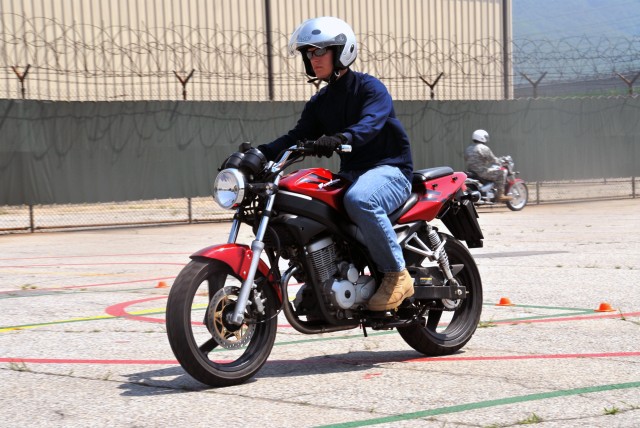CAMP MOBILE, South Korea - When Gregory Deschapell and Scott Steuerwald, instructors of the Army Traffic Safety Training Program from Cape Fox Corp. began talking about motorcycle safety, everyone listened.
There is more to riding a motorcycle and staying alive than swinging a leg over two wheels with 140 horsepower and zooming off into the wild blue yonder. Motorcycle safety is about staying alive in the most dangerous land for riding on two wheels and 48 Warriors from the 1/72 Armor came to learn how June 7-11.
Taking the course offered by the Army not only gives you the confidence to become a skilled rider, but it also introduces one to the many joys and pleasures given by motorcycle riding for pleasure. One thing to remember: never ride without protection.
At least, recommended riding gear such as a Department of Transportation or Snell Memorial Foundation approved helmet, long sleeve shirts, jacket, if not leather, one of thickness and weight to protect the skin from road rash, full-fingered gloves, thick jeans, boots that cover and protect the ankles, and a reflective vest.
The helmet should have a face shield or the rider must use approved protective goggles. Without this gear, a rider can wind up in dire shape if he is hit by another vehicle while riding. All of these facts are explained during the classroom instruction given by both Deschapell and Steuerwald.
"With this program Soldiers can learn on paper and hands-on the basics of properly operating a motorcycle," Deschappell said. "The great thing about it is the instructors are hands on as well, which means we can closely teach the Soldiers and provide them with a safe environment during the training."
For the beginners course, riders are trained to control the motorcycle using the controls such as handlebars, throttle grip, clutch, brakes both front and rear, and how to control while turning and leaning into turns so the rider can put the bike where he wants it to be. They start with what is called a power walk. This enables the rider to get used to the power of the bikes engine and not feel afraid of falling.
By the end of the course, most riders have a good grip on basic motorcycle riding skills. They need to put as many miles on their new bikes as they can to develop these skills, but never forget the safety training that will keep them alive.
"This is the best training," said Sgt. Fausto Lopez, 1-72nd Armor Regiment, owner of three motorcycles. "Everything we have been taught during this course focuses on safety, and that is good because whenever you operate any form of transportation, safety is a major issue. I think everybody who is interested in getting a motorcycle or wants to learn how to ride a motorcycle should join this class because you get the joy that comes along with riding a motorcycle while ensuring safety for yourself and others."
Some consider riding motorcycles or scooters to skirt the rising prices of gasoline.
"With gas prices elevating, riding a motorcycle seems to be the most fuel efficient form of transportation," said Spc. Mason Cromer, F Co, 302nd Brigade Support Battalion, first-time rider. "I can't wait to get a bike and explore the many benefits of riding a motorcycle. I am glad this training gave me the opportunity to do so."
For anyone interested in staying alive while riding their new motorcycle in Korea, logging on to www.ridesafe.kr is a good way to get started.


Social Sharing